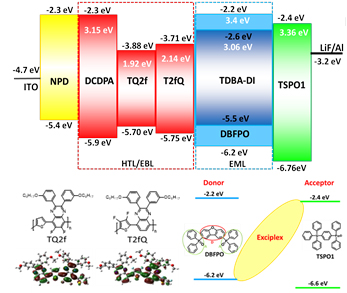A research work in the field of Light Emitting Diodes (LEDs) was published in the international journal Nature Communications with the participation of Assoc. Prof. G. C. Vougioukalakis’ research team

Blue organic light emitting diodes (OLEDs) are highly important devices, in lighting, information storage, and display applications. Noble metal-based organometallic phosphors enable the fabrication of blue OLEDs with external quantum efficiencies (EQEs) exceeding 30%. However, the high cost and limited availability of noble metal phosphors have been the driving force for developing purely organic, thermally-activated delay fluorescent (TADF) emitters, relying on radiative deactivation from singlet states with 100% quantum efficiency. Through careful design and compositional engineering of such emitters, the EQEs of blue TADF OLEDs have steadily improved from 19.5% in 2014 to 38.4% in 2021.
In this work, a device combining a low triplet energy hole transporting interlayer with high mobility (two novel fluorinated-thiophene-quinoxaline copolymers were employed), with an interface exciplex that confines excitons at the emissive layer/electron transporting material interface (combination of donor-acceptor bis(diphenylphosphine oxide)dibenzofuran –DBFPO– with diphenyl[4-(triphenylsilyl)phenyl]phosphine oxide -TSPO1- as acceptor) was developed. Blue TADF OLEDs with an external quantum efficiency of 41.2% were thus successfully fabricated. This approach paves the way for further progress through exploring alternative device engineering approaches, instead of solely focusing on the demanding synthesis of organic compounds with complex architectures.
The work was the result of an international interdisciplinary collaboration of research groups based in Greece (NKUA, NCSR “Demokritos”, and NHRF), South Korea (POSTECH), UK (Imperial College London), and Brazil (CPGEI). The NKUA research group (Post-doctoral Fellow Dr. G. Rotas and Associate Professor G. C. Vougioukalakis) synthesized and characterized certain photoactive organic molecules used in the study.
Visit Associate Professor G. C. Vougioukalakis’ research group webpage for more info on this and other works: http://users.uoa.gr/~vougiouk
